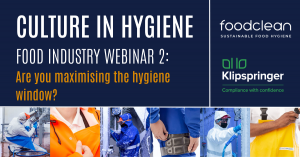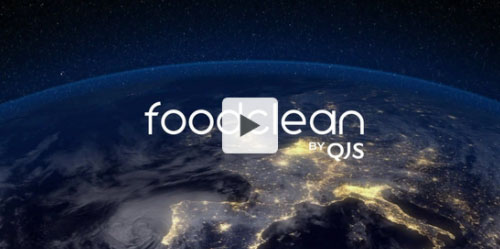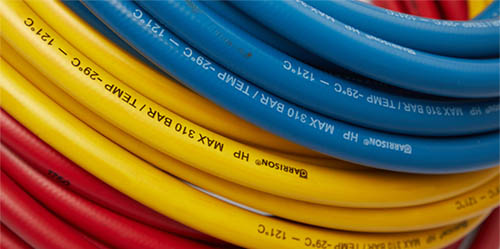Webinar 2 - Review
Cleaning Efficiency - Maximising the Hygiene Window
In the second webinar of the Culture in Hygiene Webinar series, FoodClean’s Nick Turner was joined by Alex Carlyon, Director at Klipspringer, and Technical Consultant Andy Fletcher to share thoughts and ideas regarding how food factories can maximise the hygiene window.
The role of hygiene in food production often doesn’t get the attention it deserves. With costs on the rise, it’s about making sure we’re being cost-effective at all times. Culture starts at the top of our organisations and filters down – it’s about actions, not just words. Great culture creates buy-ins from our teams. It creates willingness to get things done and to follow best practice. A good culture drives cleaning efficiency and in return, cleaning efficiency drives a good culture.
Cleaning Efficiency
Nick Turner started the discussion about cleaning efficiency by addressing its biggest barriers. Areas highlighted were:
- Hard to clean machinery – make sure hygiene or technical managers are involved in the purchasing and design stage. They can also look at what could be introduced in the manufacturing stage to drive efficiency.
- Slow preparation for cleaning – how difficult is it for your team to start the clean?
- Tools that are not up to the job or missing equipment.
- Set up and set down of the cleaning schedule.
- Lack of segregation – if operators are having to be careful to not spread debris due to production, it slows things down.
- Poor training or task clarity.
- Not enough staff.
- Poor scheduling.
“Choice of equipment is critical to ensuring it’s fit for purpose,” explained Nick. “Take an application-first approach. Ask yourself ‘what is the task to be done?’ rather than ‘what tools do I have to do it with?’ Carry out an audit and make sure your teams have everything they require. Trial equipment and get operator feedback. Conduct an equipment review and engage the equipment supplier if necessary.”
Perhaps most importantly, Nick points out that working efficiently is not expensive, as it actually saves money in the long run. Every minute you’re reducing your cleaning window, it gives money back to the business.
“It’s about the right tool, right place, right time,” Nick added. “How long should it take for operators to start cleaning? Consider a hygiene operator toolkit so that people know what they have and where to find it. Ensure tool accessibility – does it fit, and does it work?”
It’s also crucial that when it comes to cleaning and storing equipment, your hygiene teams have a clearly defined cleaning and storage process. This process must be easy to follow through visual prompts and information. The cleaning equipment itself must also be kept clean and in good working order, as this aids its longevity and serviceability. Key factors here are knowing know how to clean it, where to keep it, and what good looks like.
“Protecting machinery is key,” Nick stated, who then offers some key questions that should be asked in your food manufacturing facility: “How long does it take to protect machinery before cleaning? Is unused and unprotected equipment having to be recleaned? How much single-use plastic is being discarded when protecting machinery? Think about the environmental impact of this – is there a better way of doing it?”
Labour Efficiency
Just as important as cleaning efficiency is labour efficiency, which is another area in which Nick has plenty of knowledge that he was keen to share. His main points are to integrate the following into your hygiene culture:
- Engagement of the production team to support ‘clean as you go’ and leaving the area ready to clean.
- Time and motion exercises for labour efficiency.
- Team awareness of the cost-per-minute of downtime.
- Representation and understanding of hygiene amongst the site management team.
- Bring your hygiene workers on the journey – see them as a partner, not a problem.
- Make it easy to start and let machines do the work. Make sure that the equipment needed is in the right places, stored efficiently, and easily accessible for teams.
- Ready to use equipment reduces operator frustration, increases equipment ownership and care, and improves labour efficiency. Is it fit for purpose? Have I got the right nozzle? These questions make an enormous difference to labour efficiency.
Zone Segregation
Alex Carlyon at Klipspringer then moved the conversation to the final point, which is how zone segregation is key in ensuring cleaning efficiency.
“If we implement the right zone controls and segregations, we can achieve more in a shorter space of time,” Alex said.
It’s important to ask what the cleaning is actually for. Is it equipment efficiency, such as to prevent machine blockages? Is it product quality, such as product colouration or taint? Or is it allergen control or the removal of other food safety risks? Once this has been established, there are other questions that need asking in order to optimise the system:
- Can the cleaning be safely carried out ‘in-process’ during production?
- Is segregation required? This could be from a food safety or operator safety perspective, or something else.
Technical Consultant Andy Fletcher had some excellent points to add to this topic of discussion, with the mission being to mitigate the risks that arise during in-process cleaning. There are multiple factors to bear in mind here, such as:
- Team training so that everyone has a clear understanding of the risks.
- Effective production scheduling.
- Heavy or light screening – what type of screen might be right for the job? For instance, it could be curtains or other tailor-made solutions.
- Low pressure cleaning equipment.
- Hand tools, wipes, buckets, trolleys or trucks.
- Taking equipment elsewhere to be cleaned.
- Exchange parts – multiple sets of machine parts which can be cleaned and prepared for use. If there are low-cost parts of a machine that need to be cleaned often, could you have a few of them stored away ready for use?
- Reduced risk and increased efficiency equals a win-win situation!
- Be prepared! What happens when something interrupts the schedule? There could be line equipment breakdowns, miscalculations in production scheduling, unexpected fluctuation in volumes, or staffing issues.
“Work on your ‘what if?’ scenarios in advance,” Andy expressed. “Have equipment in place and a well-trained team that can speed up reaction time to unexpected scenarios and mitigate risks. Once they’re in place, don’t forget about them. Most of all, review and update regularly.”
You can watch the full webinar via the link below. If you enjoyed this discussion and would like to find out more about how FoodClean can support your food manufacturing facility, we recommend visiting the newly launched FoodClean Experience Centre. To book a phone call, a video meeting or a personalised tour of the FEC, get in touch with our team at info@foodclean.com



